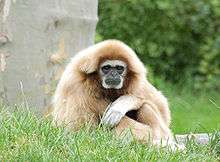Simian
| Simians Temporal range: Middle Eocene-Holocene, 40–0 Ma | |
|---|---|
 | |
| Lar gibbon | |
| Scientific classification | |
| Kingdom: | Animalia |
| Phylum: | Chordata |
| Class: | Mammalia |
| Order: | Primates |
| Suborder: | Haplorhini |
| Infraorder: | Simiiformes Haeckel, 1866[1][2] |
The simians (infraorder Simiiformes, Anthropoidea) are the monkeys, cladistically including the apes: The New World monkeys or platyrrhines, and the catarrhine clade consisting of the Old World monkeys and apes.
The simian line and the tarsier line diverged about 60 million years ago (during the Cenozoic era). Forty million years ago, simians from Africa colonized South America, giving rise to the New World monkeys. The remaining simians (catarrhines) split 25 million years ago into apes and Old World monkeys.
Classification and evolution
In earlier classification, New World monkeys, Old World monkeys, apes, and humans—collectively known as simians or anthropoids—were grouped under Anthropoidea (/ˌænθɹoˈpɔɪdiə/, Gr. άνθρωπος, anthropos, human, also called anthropoid apes), while the strepsirrhines and tarsiers were grouped under the suborder "Prosimii". Under modern classification, the tarsiers and simians are grouped under the suborder Haplorhini while the strepsirrhines are placed in suborder Strepsirrhini.[3] Despite this preferred taxonomic division, prosimian is still regularly found in textbooks and the academic literature because of familiarity, a condition likened to the use of the metric system in the sciences and the use of customary units elsewhere in the United States.[4] In anthropoidea, evidences indicate that the Old and the New World primates went through parallel evolution.[5]
Primatology, paleoanthropology, and other related fields are split on their usage of the synonymous infraorder names, Simiiformes and Anthropoidea. According to Robert Hoffstetter (and supported by Colin Groves), the term Simiiformes has priority over Anthropoidea because of the taxonomic term Simii by van der Hoeven, from which it is constructed, dates to 1833.[1][6] In contrast, Anthropoidea by Mivart dates to 1864,[7] while Simiiformes by Haeckel dates to 1866, leading to counterclaims of priority.[1] Hoffstetter also argued that Simiiformes is also constructed like a proper infraorder name (ending in -iformes), whereas Anthropoidea ends in -oidea, which is reserved for superfamilies. He also noted that Anthropoidea is too easily confused with "anthropoïdes", which translates to "apes" from several languages.[6]
The simians are split into three groups. The New World monkeys in parvorder Platyrrhini split from the rest of the simian line about 40 [mya (unit), leaving the parvorder Catarrhini occupying the Old World. This group split about 25 mya between the Old World monkeys and the apes. "Monkeys" are a paraphyletic group (in other words, not a single coherent group).
Classification
| Phylogeny of living (extant) primates | |||||||||||||||||||||||||||
| |||||||||||||||||||||||||||
| Cladogram. For each clade, it is indicated approximately how many million of years ago (Mya) newer extant clades radiated. |
The following is the listing of the various simian families, and their placement in the order Primates:[1][2]
- Order Primates
- Suborder Strepsirrhini: non-tarsier prosimians
- Suborder Haplorhini: tarsiers + monkeys, including apes
- Infraorder Tarsiiformes
- Infraorder Simiiformes
- Parvorder Platyrrhini: New World monkeys
- Family Callitrichidae: marmosets and tamarins
- Family Cebidae: capuchins and squirrel monkeys
- Family Aotidae: night or owl monkeys (douroucoulis)
- Family Pitheciidae: titis, sakis and uakaris
- Family Atelidae: howler, spider and woolly monkeys
- Parvorder Catarrhini
- Superfamily Cercopithecoidea
- Family Cercopithecidae: Old World monkeys
- Superfamily Hominoidea
- Family Hylobatidae: gibbons
- Family Hominidae: great apes, including humans
- Superfamily Cercopithecoidea
- Parvorder Platyrrhini: New World monkeys
See also
- Simia, Carl Linnaeus's original classification of these primates.
References
| Wikiquote has quotations related to: Simians |
| Wikispecies has information related to: Simian |
- 1 2 3 4 Groves, C.P. (2005). "Simiiformes". In Wilson, D.E.; Reeder, D.M. Mammal Species of the World: A Taxonomic and Geographic Reference (3rd ed.). Baltimore: Johns Hopkins University Press. p. 128. OCLC 62265494. ISBN 0-801-88221-4.
- 1 2 Rylands AB & Mittermeier RA (2009). "The Diversity of the New World Primates (Platyrrhini)". In Garber PA, Estrada A, Bicca-Marques JC, Heymann EW & Strier KB. South American Primates: Comparative Perspectives in the Study of Behavior, Ecology, and Conservation. Springer. ISBN 978-0-387-78704-6.
- ↑ Cartmill, M.; Smith, F. H (2011). The Human Lineage. John Wiley & Sons. ISBN 978-1-118-21145-8.
- ↑ Hartwig, W. (2011). "Chapter 3: Primate evolution". In Campbell, C. J.; Fuentes, A.; MacKinnon, K. C.; Bearder, S. K.; Stumpf, R. M. Primates in Perspective (2nd ed.). Oxford University Press. pp. 19–31. ISBN 978-0-19-539043-8.
- ↑ Lull, Richard Swann (1921). "77". Organic Evolution. New York: The Macmillan Company. pp. 641–677.
- 1 2 Hoffstetter, R. (1974). "Phylogeny and geographical deployment of the Primates". Journal of Human Evolution. 3 (4): 327–350. doi:10.1016/0047-2484(74)90028-1.
- ↑ Tobias, P. V. (2002). "The evolution of early hominids". In Ingold, T. Companion Encyclopedia of Anthropology: Humanity, Culture and Social Life. Taylor & Francis. p. 35. ISBN 978-0-415-28604-6.
External links
- BioMed Central Full text Gene conversion and purifying selection of a placenta-specific ERV-V envelope gene during simian evolution
- ADW Simiiformes Classification
- Taxonomy browser (Simiiformes)
- Late middle Eocene epoch of Libya yields earliest known radiation of African anthropoids
- Mouse-Sized Primates Shed Light on Human Origins